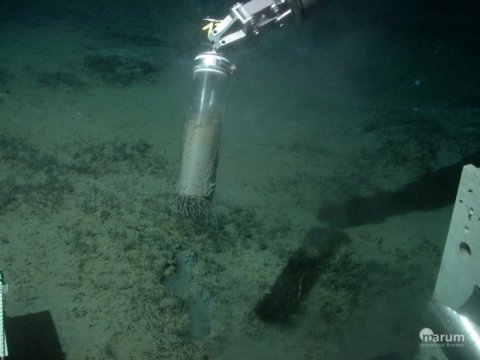[ad_1]
Large quantities of the greenhouse gas methane are stored in the seabed. Fortunately, only a small fraction of the methane reaches the atmosphere, where it acts as a climate-relevant gas, as it is largely degraded within the sediment. This degradation is carried out by a specialized community of microbes, which removes up to 90 percent of the escaping methane. Thus, these microbes are referred to as the “microbial methane filter.” If the greenhouse gas were to rise through the water and into the atmosphere, it could have a significant impact on our climate.
But not everywhere the microbes work so efficiently. On sites of the seafloor that are more turbulent than most others — for example gas seeps or so-called underwater volcanoes -, the microbes remove just one tenth to one third of the emitted methane. Why is that? Emil Ruff and his colleagues from the Max Planck Institute for Marine Microbiology and the University of Bremen aimed to answer this question.
Methane consumption around a mud volcano
In the North Sea off Norway at 1250 meters water depth lies the Håkon Mosby mud volcano. There, warm mud from deeper layers rises to the surface of the seafloor. In a long-term experiment, Ruff and his colleagues were able to film the eruption of the mud, take samples and examine them closely. “We found significant differences in the different communities on-site. In fresh, recently erupted mud there were hardly any organisms. The older the mud, the more life it contained,” says Ruff. Within a few years after the eruption, the number of microorganisms as well as their diversity increased tenfold. Also, the metabolic activity of the microbial community increased significantly over time. While there were methane consumers even in the young mud, efficient filtering of the greenhouse gas seems to occur only after decades.
“This study has given us new insights into these unique communities,” says Ruff. “But it also shows that these habitats need to be protected. If the methane-munchers are to continue to help remove the methane, then we must not destroy their habitats with trawling and deep-sea mining. These habitats are almost like a rainforest — they take decades to grow back after a disturbance. “
International deep-sea research
Antje Boetius, co-author of the study, director of the Alfred Wegener Institute Helmholtz Center for Polar and Marine Research (AWI) and head of the research group for deep-sea ecology and technology at the Max Planck Institute in Bremen and the AWI, emphasizes the importance of national and international research cooperations to achieve such research results: “This study was only possible through the long-term cooperation between the AWI, the MARUM — Center for Environmental Sciences of the University of Bremen and the Max Planck Institute for Marine Microbiology with international partners in Norway, France and Belgium. Through various EU projects, we have been able to use unique deep-sea technologies to study the Håkon Mosby mud volcano and its inhabitants in great detail,” says Boetius.
Story Source:
Materials provided by Max Planck Institute for Marine Microbiology. Note: Content may be edited for style and length.
[ad_2]















